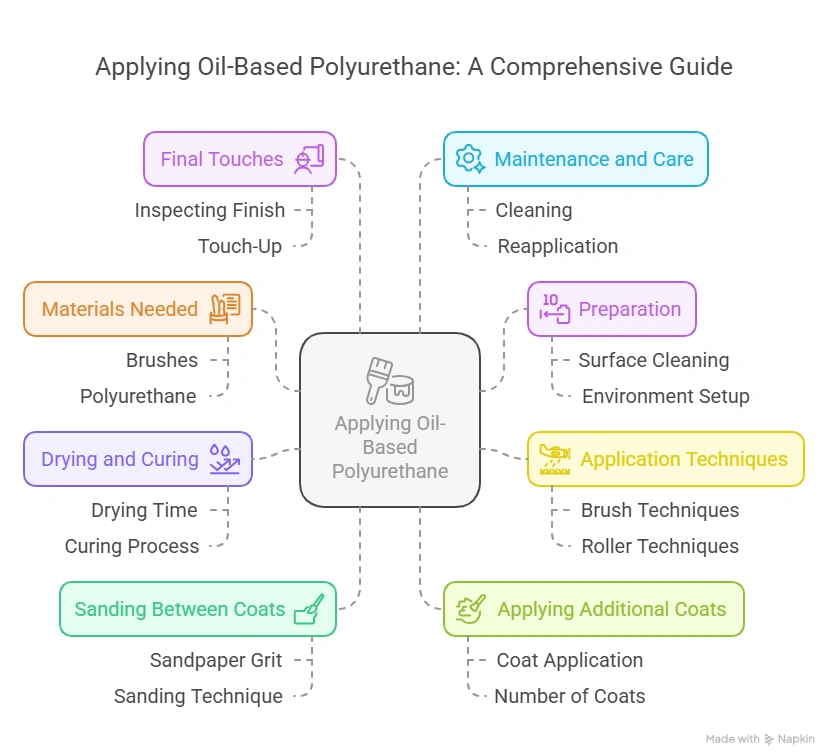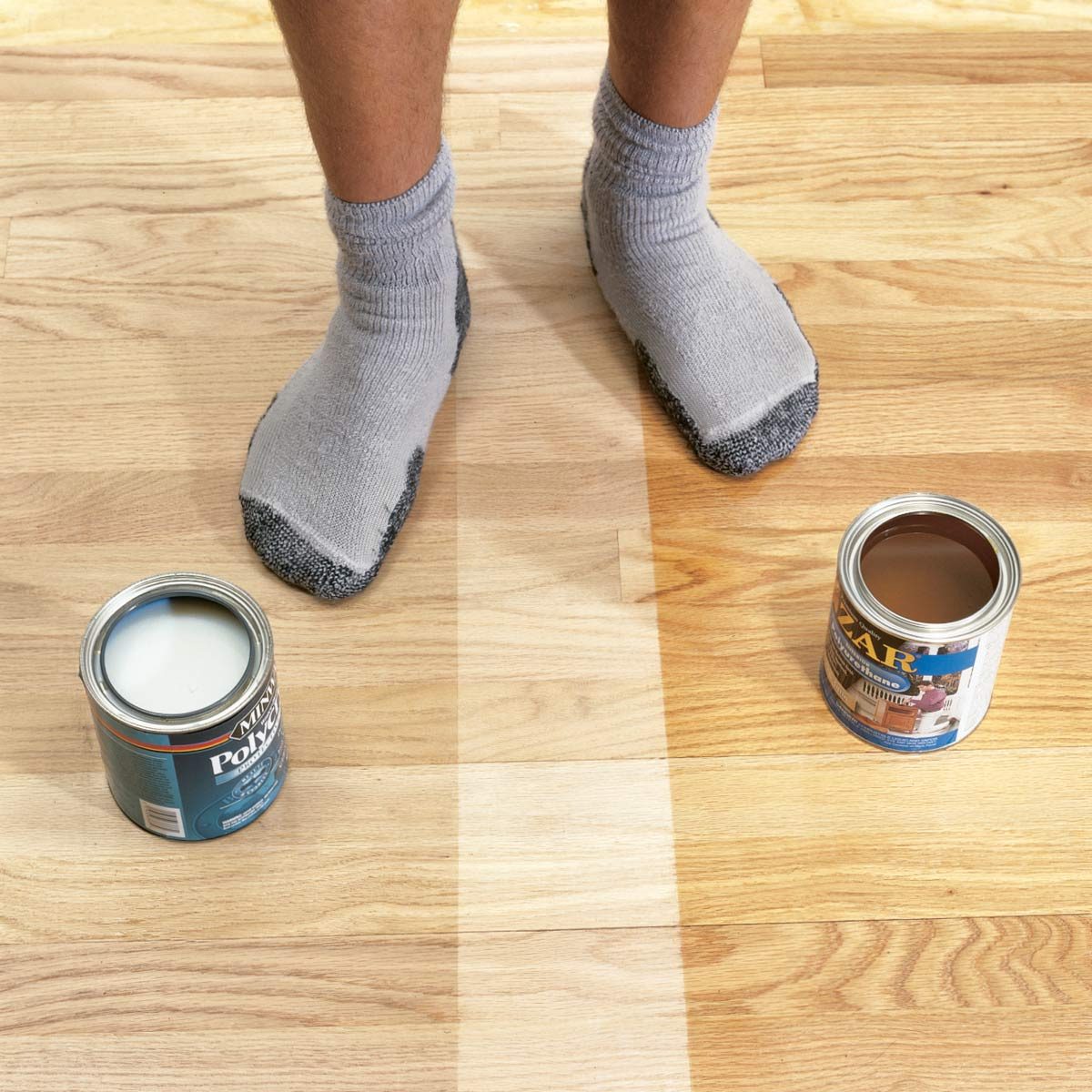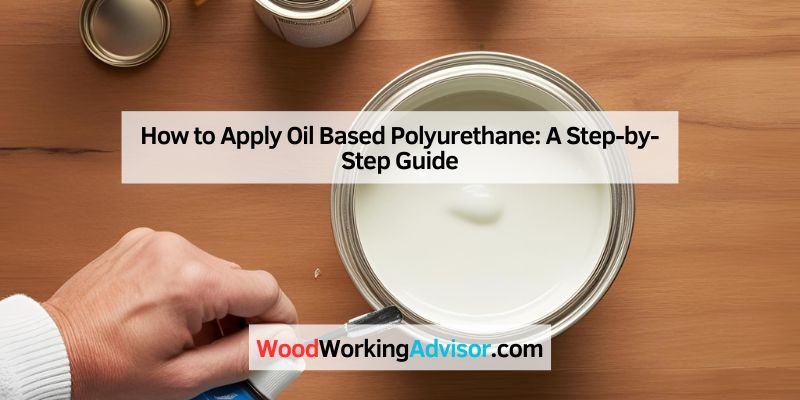Applying oil-based polyurethane can protect and enhance wood. It’s a valuable skill for any DIY enthusiast.
Oil-based polyurethane offers a durable, glossy finish that brings out the natural beauty of wood. This guide explains how to apply it properly. Whether you’re working on furniture or floors, the right technique ensures a smooth, long-lasting finish. You’ll learn about the necessary tools, preparation steps, and application tips.
This process may seem tricky at first, but with patience and practice, you can achieve professional results. So, let’s dive into the steps and get your wood projects looking their best.

Credit: angelamariemade.com
Materials Needed
Gathering the right tools is important. You will need a good quality brush. A foam brush can also work well. A lint-free cloth is necessary for cleaning. Sandpaper with 220-grit is good for smoothing surfaces. A tack cloth helps to remove dust. A stir stick is useful for mixing the polyurethane.
Safety is very important. You need gloves to protect your hands. Safety goggles keep your eyes safe. A mask protects you from fumes. Wear old clothes to avoid stains. Make sure your workspace is well-ventilated.
Preparation
Make sure the surface is free of dust. Use a damp cloth to wipe it. Let it dry completely before moving on. Any dirt left will affect the finish. Clean corners and edges well. This ensures a smooth look.
Start with coarse sandpaper. Sand the surface evenly. This removes old finishes and smooths the wood. Move to finer sandpaper for a smooth finish. Always sand in the direction of the wood grain. This avoids scratches. Wipe away dust with a clean cloth. Repeat if necessary until smooth.

Application Techniques
Using the right brush is very important. Natural bristle brushes are the best choice. They hold the polyurethane well. This helps in smooth application. Synthetic brushes are not suitable. They can leave marks on the surface. Foam brushes can be used for small areas. They are good for touch-ups. Avoid cheap brushes. They may shed bristles. This will ruin your finish.
Start by stirring the polyurethane gently. Do not shake the can. Apply a thin coat evenly. Use long, smooth strokes. Do not overload the brush. It can cause drips. Work in one direction. This ensures a smooth finish. Let the first coat dry. This may take several hours. Once dry, sand lightly with fine sandpaper. This helps the next coat stick better.

Credit: www.familyhandyman.com
Drying And Curing
Oil based polyurethane usually dries in about 24 hours. Dry time can vary. Check the product label. Some types may dry faster. A thicker layer will take longer. Thin coats dry quicker. Be patient. Rushing can ruin the finish.
Ideal conditions are key for curing. The room should be warm. About 70°F (21°C) is best. Good air flow helps too. Open windows if possible. Avoid high humidity. It can slow down the process. Keep dust away from the surface. Clean the area before you start. The right conditions make a big difference.
Sanding Between Coats
Sanding between coats is important. It helps the polyurethane stick well. Wait until the coat is dry. This usually takes about 24 hours. You can touch it to check. If it’s not sticky, it’s time to sand.
Choose the right sandpaper grit. Use 220 grit sandpaper. It is fine enough for this job. This sandpaper won’t remove too much polyurethane. Sand lightly and evenly. Avoid pressing hard. This keeps the surface smooth and ready for the next coat.

Credit: www.homedepot.com
Applying Additional Coats
Applying additional coats of oil-based polyurethane involves sanding lightly between layers. This helps the next coat to adhere properly. Always ensure each coat is fully dry before the next application.
How Many Coats Needed
For a durable finish, 3 to 4 coats of oil-based polyurethane are recommended. The first coat seals the wood. The next coats build up the protective layer. Sand lightly between coats for best results. Use fine-grit sandpaper. Ensure each coat is dry before applying another. Patience is key for a smooth finish.
Tips For A Smooth Finish
Use a high-quality brush or foam applicator. Apply thin, even coats. Avoid bubbles by applying slowly. Sand between coats with fine-grit sandpaper. Clean dust off before the next coat. Work in a dust-free area. Ensure good ventilation. Allow proper drying time. Avoid touching the surface during drying.
Final Touches
Check for bubbles and streaks in the polyurethane. Ensure the surface is smooth and even. Look for any missed spots. If you find any flaws, sand them lightly and apply another coat. Let the polyurethane dry completely before you inspect again.
Clean your brushes with mineral spirits or paint thinner. Wipe down any surfaces with a damp cloth. Dispose of any used rags and cleaning materials properly. Store leftover polyurethane in a cool, dry place. Make sure all lids are tightly sealed. Proper cleaning ensures tools are ready for next use.
Maintenance And Care
Dust the surface gently with a soft cloth. A vacuum with a brush attachment can also help. For sticky spots, use a damp cloth with mild soap. Avoid harsh chemicals. They can damage the finish. Dry the surface completely after cleaning. Water can harm the wood.
Small scratches can be fixed with a touch-up marker. Rub the marker over the scratch. Then, wipe off the excess. For larger areas, lightly sand the spot. Then apply a thin coat of polyurethane. Let it dry well. Repeat if needed. Always follow the grain of the wood.
Frequently Asked Questions
What Is The Best Way To Apply Oil-based Polyurethane?
Apply oil-based polyurethane with a high-quality brush or foam applicator. Sand lightly between coats. Ensure a clean, dust-free surface.
Is It Better To Apply Polyurethane With A Brush Or Rag?
Applying polyurethane with a brush provides a smoother finish. Using a rag offers better control for touch-ups. Choose based on your project’s needs.
What Is The Best Applicator For Oil-based Polyurethane On Floors?
A lambswool applicator is best for oil-based polyurethane on floors. It provides a smooth, even finish without streaks.
What Is The Downside Of Oil-based Polyurethane?
Oil-based polyurethane emits strong fumes and takes longer to dry. It can yellow over time and is difficult to clean up.
Conclusion
Applying oil-based polyurethane can protect and enhance your wood surfaces. Follow these steps for a smooth and durable finish. Start with a clean surface. Then, apply thin, even coats. Sand lightly between coats for the best results. Always work in a well-ventilated area.
Be patient and let each layer dry completely. With practice, your wood projects will shine beautifully and last longer. Enjoy the process and the final outcome. Happy woodworking!

